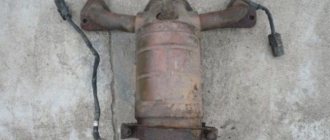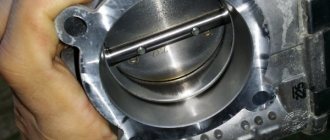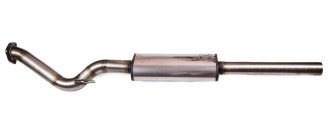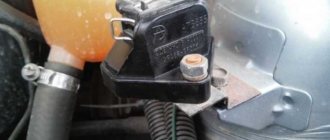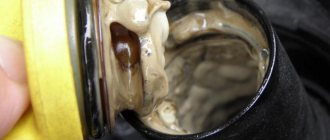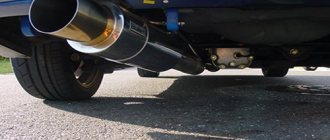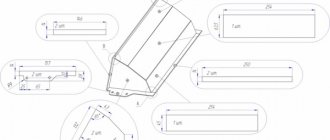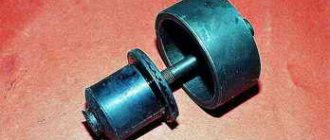What is an intake manifold and what is it for?
Whatever the engine runs on - gasoline, diesel, gas - it needs air, a lot of clean, cool, “tasty” air. The intake manifold is used to supply it correctly.
Essentially, this is a pipeline of a certain shape and size that is needed to deliver the required amount of air to the cylinders. In addition, it is responsible for mixing air with fuel from the injectors in an injection engine. But if everything were so simple, engineers would not be searching for the ideal collector geometry for each new motor.
In modern cars, the intake manifold performs several tasks:
- Supply the required amount of air to prepare a stoichiometric fuel mixture (that is, with an optimal ratio of fuel to air);
- Evenly distributes the air flow between the engine cylinders;
- Since there is a constant vacuum in the manifold due to the suction effect from the engine pistons, engineers came up with the idea of using this vacuum (vacuum) to increase braking forces, to ventilate crankcase gases, etc., depending on the make and type of car.
- Creates a resonant air flow to increase its speed without additional equipment.
Intake manifold flaps and other structural elements
Most often, the intake manifold is mounted on the left side of the cylinder head. In the modern world, due to the development of technology, this part is made from aluminum alloys or other composite plastic materials.
The sensor, which is located on the intake manifold, records the pressure and temperature, and the control unit directly calculates the entire mass of air located in it. Based on the data obtained, certain pulses are generated, with the help of which direct control of the injectors is carried out. This is how air and fuel of a given composition are mixed.
In the middle of the device itself there is a switch shaft and a vacuum element. Vacuum is supplied to the same element through the flaps into the intake manifold pipe. This vacuum is generated by a tandem pump. Each intake channel is divided into a filling section and a vortex section. The switch shaft, in turn, can only cover the filling section. It is at this moment that exhaust gases are sucked out through the vortex channel. Thus, the flow speed in this channel increases significantly.
Design and principle of operation
In order for the intake manifold to perform all the tasks assigned to it, it must have a strictly calculated geometric shape. For example, to ensure that the flow inside does not slow down, the collector is designed without corners and straight lines. Smooth curves and rounded shape contribute to more powerful air flow.
Intake manifold device
At the entrance to the intake manifold there is a carburetor or a throttle valve if we are talking about an injection engine. The central channel is divided into separate sleeves - runners, which fit the cylinders, or rather, the intake valves.
Fuel injectors are located near the intake valves (in a multipoint injection system) or in the central channel if mono injection is installed.
According to the shape of the inlet channel, single-plane and two-plane are distinguished:
- Single-plane - with only one channel for the passage of air or fuel-air mixture. These collectors pass a large amount of air per unit of time, which means they allow the engine to develop the maximum possible power at high speeds;
- Biplanar - those in which the channel is divided into two parts. They make it possible to obtain more power output at low and medium engine speeds.
Operating principle of the intake manifold
During the downward movement of the pistons, a vacuum effect is formed: the flow of the mixture in the manifold rests against the closed intake valve at the stroke of the engine. As the speed increases, the mixture in the intake manifold is reflected from obstacles and begins to make “oscillatory movements.” After the formation of such movements, the flow of the mixture moves at a higher speed. Under certain conditions, such oscillations become resonant, as a result of which the mixture enters the cylinders with high pressure (the process is called resonant charging).
A properly designed manifold ensures better ventilation of the cylinders. This occurs due to the pressure difference in the intake and exhaust tracts. Valves for the intake and exhaust of gases have a certain advance step of the engine stroke. It is necessary that the valve be maximally open or closed at the optimal moment, that is, during one cycle of cylinder operation, both valves are slightly open for a fraction of a second. The pressure at the inlet becomes slightly higher than at the outlet (where gases have already been released). This ensures more efficient purging of the combustion chamber.
Intake manifold tuning
Fans of auto tuning do not ignore the intake manifold. With the right approach, it is indeed possible to improve engine power performance, an example in the video below.
Tuning options:
- Improving your form. It is quite difficult to ensure that all cylinders of the engine receive the same amount of air. Therefore, the craftsmen replace the standard manifold with a multi-throttle intake. A separate throttle is installed on each engine cylinder, creating an independent system.
- Improving the internal surface. During the production of collectors, small errors may remain on the internal part: sagging, burrs, roughness. This slows down the air flow a little, so craftsmen grind the inner surface of the collector to remove all obstacles.
Repair and maintenance of intake manifolds
A modern intake manifold is a complex part. Breakdowns also happen to it. Let's look at typical ones.
Leakage problems
This is the first problem with intake systems, as well as many other components of the car. Vibrations, changes in humidity, pressure and temperature affect rubber (paranitic, etc.) seals, of which there are quite a few in complex intake systems. Additional air may enter the mixture, the so-called “suction”.
Additional portions of oxygen deplete the mixture, the engine loses traction, and problems with idle speed appear. There may be engine ECU errors. All these symptoms indicate problems with the tightness of the intake tract.
Air leaks in the intake manifold can significantly affect the dynamic performance of the engine as a whole. After the seal is restored, engine operation returns to normal.
Gaskets for intake and exhaust manifolds of VAZ 2106
Intake manifold contamination
The intake tract must be checked from time to time for deposits on the walls. A problem like this can have a significant impact on the dynamics of the car. The manifold becomes clogged especially often on engines with an exhaust gas recirculation system. In such cases, it is necessary to disassemble and clean the device with a special compound.
This is interesting: There are many ways to fix threads:
Deposits on the walls of the intake manifold elements
Deformations and mechanical damage to the housing
Plastic and aluminum are widely used for the production of collectors, and these materials, as is known, can be deformed due to exposure to high temperatures. Plastic cracks and dries out over time. Aluminum manifolds may burst due to vibrations.
Elements with severely damaged geometry must be replaced. Aluminum parts can be welded using argon arc welding.
Increased air temperature in the intake manifold
The causes of this problem may be:
- long-term idling in conditions of high air temperature (for example, in traffic jams);
- malfunctions of the cooling system and an increase in the overall engine temperature;
- poor ventilation of the engine compartment due to a clogged radiator;
- erroneous reading of the temperature sensor in the intake manifold;
- errors in the control unit firmware.
The solution is to check the cooling system components and diagnose electronic systems.
Types of intake manifolds
There are the following types of intake manifolds:
- steel;
- aluminum;
- plastic;
- with variable geometry;
- with exhaust gas control valves (EGR);
- turbocharged;
- with point fuel injection, etc.
On modern engines, manifolds with point fuel injection are quite common. In this modification, fuel is supplied using electromagnetic injectors installed in each of its pipe-channels.
Schematic diagram of an intake manifold with point fuel injection
The intake manifold, like the engine as a whole, operates productively within a certain speed range. The design and type of installed manifold depends on the layout of the cylinder block, on the target orientation of the engine and on design solutions in general.
Why might you need to repair the intake manifold?
At its core, the intake manifold has a rather complex design. Based on these considerations, the likelihood of breakdown or malfunction of a certain individual element of the entire device increases significantly. Dampers often fail (mainly on German car brands).
In this case, the car becomes very weak and significantly loses power. At the same time, fuel consumption increases significantly, and traction and engine performance generally deteriorate. Manifold flaps fail for several reasons: low-quality material used to make these flaps, too high a temperature, and the presence of oil condensate.
In addition, the control valve for these intake manifold flaps may also fail. A sign that oil consistency has entered the intake manifold is its increased consumption, which can exceed 1 liter per 1 thousand km.
In parts that are made of plastic, you can often encounter a problem that involves disconnecting the tube from the swirler. This, in turn, gives rise to a certain characteristic sound during actual movement: noise and crackling in the car. This breakdown can be completely solved even with your own hands.
In addition, air leaks may occur in the intake manifold itself. This breakdown may affect the vehicle's power. But the most important thing is that there will be a serious noise that resembles suction or blowing.
In automotive nature, there is a special sensor that is used to measure the absolute pressure in the intake manifold. This sensor, in addition to the above function, is responsible for optimizing combustion processes and the formation of a mixture of air and fuel. If this sensor fails, then most likely the electronic control unit will begin operating in emergency mode.
Sometimes it happens that the engine cannot be started at all. The design of the modern sensor, located in the intake manifold, is quite reliable. And yet, malfunctions in it are possible.
